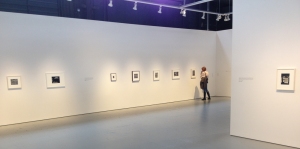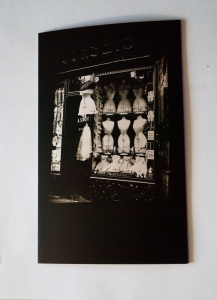This exhibition was on my absolute “must see” list. It featured some of the “photographer-greats” like Berenice Abbott, Roy Arden, Eugéne Atget, Phil Bergerson, Manuel Alvarez Bravo, Harry Callahan, Walker Evans, Lee Friedlander, Lorraine Gilbert, Fred Herzog, Geoffrey James, Abelardo Morell, Aaron Siskind, Bruce Stewart, Weegee and David Wisdom. Admittedly there were a quite a few names there that I hadn’t heard of before.
Pictured Windows is an exhibition that “explores the duality of window pictures and the contrast between what is presented and what is reflected”. Spanning the twentieth century the exhibition focuses on the cultural significance of the shop windows, the surreal possibilities that occur in reflective glass, inventory of cities. A quote by Susan Sontag on the wall at the entrance of the gallery reads:
[the photographs bring] to our attention the coexistence of sewing machine and umbrella, that chance meeting, which a great Surrealist poet has praised as the essence of beauty.
I think my favourite image in the entire exhibit would have to be Eugene Atget’s Corsets. There is something intriguing about the horizontal and vertical alignment of the mannequins displaying the corsets. It’s an image full of historical data and even probably rather risque for that time period. Did ladies publicly display their undergarments in the late 1800’s or early 1900’s? Or was this a shop for the ladies of the night? I think this image also reveals a little of the photographer’s romantic nature. The fact that the photograph is taken slightly to the side seems to suggest that the photographer did not want to intrude on the female domain by appearing to be too voyeuristic, although he was the original flâneur in the photographic world. Looking at those mannequins in the shop window it seems crazy that women willingly subjected their bodies to such restraining and harmful contraptions all in the name of fashion. But then I look at the young girls of today and can make the same statement about the six inch platform heels that they wear. Fashion is a vicious cycle. Its only the product that changes, but the end goal is always the same – to appear sexy.
Berenice Abbott’s photos are extremely interesting to read. Each image is crammed full of details, almost majestic in adornments. The huge Roman soldier and Indian chief in Sumner Healey’s Antique Shop, the huge ‘in your face’ signage above the shop front in Rothman’s Pawnshop, the interesting statue outside the Snuff Shop to the window obscured by product prices of Jacob Heymann Butcher Shop, 345 Sixth Avenue are all a sliver of New York history. They represent a time that is past. A time when pride was taken in displays, when individuality was the norm and not the exception as it is today.
Geoffrey James and Lee Friedlander’s window photographs are similar in style. Lots of layers with the photographer’s reflection and that of the city scene behind him reflected in the photograph.
Walker Evans’ Fish Market near Birmingham, Alabama is a delightful image to study. The sign at the top of the building reads “The old reliable house mover”, but just below that under the eaves is a sign stating “Fish & honest weights, square dealings” with two signs on either side of the door listing the prices of the various fish. But in the window and in front of the shop are pumpkins, potatoes and watermelons on display. If one looks through the door and windows of the shop, one sees a few men sitting casually on porch of the building behind. The incongruity of it all makes one wonder what really happens at this place. I found his images to be amazingly sharp with excellent tonal variation.
Some of Phil Bergerson’s images were quite humorous – Springfield, Missouri [we buy men used] to name one. The red trimmed shop with its windows adorned with white paper, blocking all view from the outside has a sense of mystery to it. Especially when one takes the sign into account. The sign says it all, “we buy men used 29 and up”. But in the reflection juxtaposed to the sign one can see the photographer, clearly a man. However, the man is not standing in the normal photographer’s pose. He stands astride with his right arm across his chest and the left hand in his pocket, almost as if he is a customer considering his options before entering the shop.
I liked David Wisdom’s St Martins Kennels Aviaries & Aquaria, Shelton Street, London 1985 with its horizontal and vertical patterns dominating the image and the lovely saturated green of the building with the softer, muted shades of the window shutters. The closed doors and barred windows makes me want to explore the building. If it is so interesting from the outside, what does it look like inside?
Bruce Stewart’s Walk-ins Welcome photograph is a humorous example of the Gestalt Law of Proximity and Similarity. Four mannequin torsos with legs stand outside a store dressed in pants. The first three mannequins all display various signs displaying from inside the waistband enticing shoppers to make a purchase. A couple even have a few more signs pinned to the pants legs. To the extreme right of the mannequins is another torso, standing akimbo, but this torso has arms and a camera and is clearly someone, probably a tourist posing next to the four mannequins. But my eyes keeps going back to the fourth mannequin because something is bothering me. This mannequin has no sign attached to it. It has no sign in its waistband, instead something with a patterned material is tucked into the waistband and it appears to be oval in shape. On closer inspection I notice that this torso is not standing on a pedestal as the other three are. A clever guise!
There was also a good selection of Fred Herzog’s shop windows on exhibit and as I have reviewed his work in a previous posting when working on the Colour project, I will not cover it here. It really is worthwhile going to see the “old masters” in the flesh so to speak and I’m so glad I put it on my must-see list.
The exhibit can be seen online at the Equinox Gallery website.
References
Pictured Windows. Equinox Gallery [online]. Available from: http://equinoxgallery.com/artists/portfolio/pictured-windows [Accessed 7 April, 2015]


